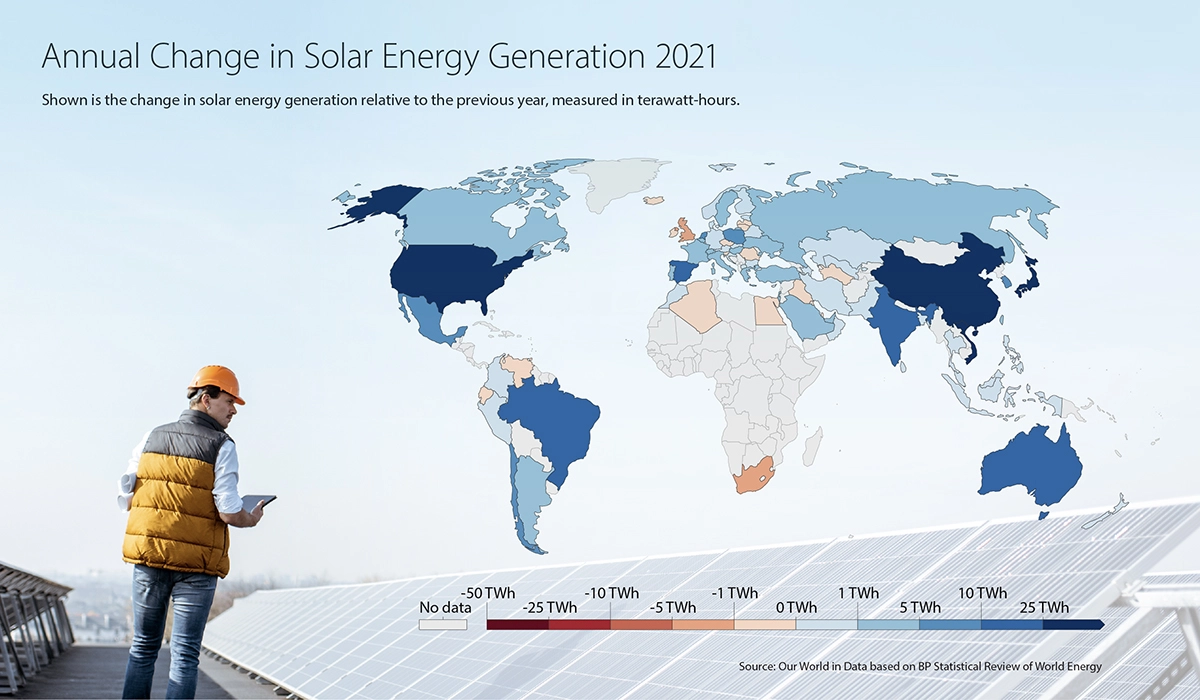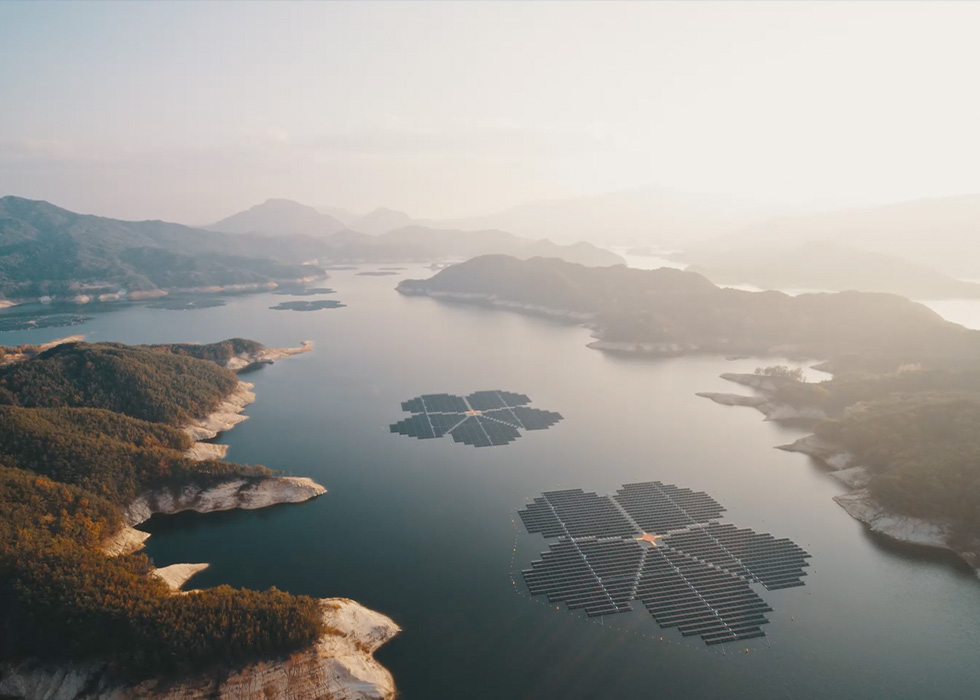The Solar Solution to Rising Gas Prices: How Hanwha’s Downstream Solar Business is Building Energy Security and Bringing Value to Consumers

Another day, another petrol price record. In June 2022, the average cost of filling up a typical family car exceeded 100 pounds ($125 USD) for the first time in Britain. In the first quarter of 2022, short-term gas prices on the largest European exchange were five times higher than their 2021 average. In addition, futures markets are pricing European gas at two or three times their 2021 levels for at least the next three years. However, this isn’t the first time world oil and gas prices have experienced significant spikes, and it certainly won’t be the last. Increasing and inconsistent fuel prices have left drivers across the country, and across the world, wondering when they will level out, if ever.
But why are gas prices so high? Several factors have been blamed for the price swings, including shifts in sentiment among customers and investors, carbon pricing, the post-COVID-19 surge in global demand and, most recently, the Ukraine war. While prices have somewhat eased recently, this energy crisis serves as a strong example of the need for improved energy security, defined as stable access to energy sources on a timely, sustainable and affordable basis.
The price shocks in Europe and around the world have highlighted the urgency of increasing green energy options available to consumers who feel the pain of gas prices in their wallets. Customers are looking for solutions insulated from highly volatile fossil fuel prices, which is where Hanwha's expanded investment in solar power projects, particularly the downstream solar business, comes into play.
As a leading solar solutions provider, Hanwha Solutions has established a robust value chain—from equipment manufacturing and research and development to powerplant operations and management and energy retail—to deliver sustainable energy to customers in Europe and around the world. Read more to learn how Hanwha is utilizing vertical integration and expanding its downstream solar business to establish a smart, strong and stable network, handling everything from module production to energy supply.

Expanding the Solar Supply Chain
Hanwha is committed not only to facilitating the world’s transition to green energy, but also to building out a clean solar supply chain from the ground up. A supply chain encompasses everything from supplier delivery of raw materials to the manufacturer to its eventual delivery to the end user. Hanwha’s solar supply chain consists of both upstream and downstream operations. An upstream supply chain includes all activities related to its suppliers who source raw material inputs to send to the manufacturer. By contrast, a downstream supply chain refers to the movement of finished goods from a business to its customers.
Hanwha is well known for its upstream supply chain which sources the materials for and manufactures solar cells, modules and other energy systems solutions. Currently, solar panels are manufactured at Hanwha Qcells plants in four countries which have a combined capacity of up to 11.3 GW of solar energy each year—enough to provide power to more than 10 million people. Hanwha has also recently invested in “clean polysilicon” manufacturer REC Silicon to expand its clean energy portfolio. The company plans to harness hydropower-based energy to produce polysilicon, a key solar panel component, thus providing a future source of eco-friendly raw materials for the U.S. solar market.
Now, Hanwha is expanding its solar energy business into the downstream side with a series of ambitious acquisitions and developments. Hanwha’s various solutions are already sold through a global business network spanning 40 markets, but with these recent investments, Hanwha seeks to achieve synergy through total ownership of the solar supply chain.
From cell production to powerplant construction and project financing, Hanwha aims to offer a seamless end-to-end experience to consumers, delivering improved supply chain stability and more environmentally friendly practices across the globe. After all, moving from foreign dependence on fossil fuels to foreign dependence on clean energy won’t help countries ultimately achieve energy independence and meet climate targets. With Hanwha’s downstream supply chain, which consists of power generation system equipment, installation, solar powerplants and more, Hanwha will be able to supply green energy to both manufacturers and consumers. That’s why Hanwha is amping up its efforts for solar projects to help combat the energy crisis in Europe and promote energy independence and security globally.

Can Clean Energy Replace Fossil Fuels?
What are the benefits of choosing clean energy over fossil fuels? There are pros and cons to both, and the two energy sources have a huge impact on the environment, energy sector, everyday life and the future of our planet.
Generally, fossil fuels are considered one of the most reliable resources that offer near-constant availability. For instance, whether you want to go for a drive at 2 a.m. or 2 p.m., you only need a full tank of gas to hit the road. However, the recent energy crisis has highlighted that oil and gas are also political commodities. Suppose a country or region is too reliant on foreign oil. In that case, that country is vulnerable if the supply is cut off—as seen in Germany, which suffered a supply cut to its gas pipeline in July 2022. Fossil fuels in general are also in limited supply. Once the planet runs out, it will take millions of years for this non-renewable energy source to replenish. Furthermore, burning fossil fuels for electricity, heat and transportation greatly contributes to climate change as it is the largest source of greenhouse gas emissions from human activities.
In contrast, clean energy can diversify a country’s energy supply and reduce dependence on imported fuels. Renewables are also much better for the environment, producing fewer carbon emissions than fossil fuels over their lifetime. Of all the sources of clean energy, solar energy alone accounts for more than half of all renewable power expansion in 2021, followed by wind and hydropower. According to a report released by the International Renewable Energy Agency (IRENA) in 2021, solar energy and onshore wind are the most cost-effective ways of introducing new electricity-generating plants in most countries.
Clean energy is still an emerging technology, and improvements must be made. However, this technology is advancing every day, and the adoption of clean energy continues to break records each year. A full transition from fossil fuels to renewable, clean energy will not happen overnight, but as international politics remain in a state of upheaval and the harmful effects of climate change compound, the need for this transition becomes more urgent. Hanwha is helping to facilitate that transition in countries around the world through its solar supply chain, specifically its expansion into the downstream solar business.

Holistic Partner in Green Energy
With costs for renewable energy continuing to fall and draw closer to parity with fossil fuels, now is a great time for solar energy projects. For Hanwha’s downstream solar supply, that means investing in system solutions, energy retail and overseas and domestic project development.
Hanwha Qcells has already secured the number one market share in U.S. residential and commercial solar photovoltaic (PV) module segments, and the company is charged and ready for its next phase of expansion in Europe. Why Europe specifically? For years, Europe has been a trailblazer in the green energy sector. The region continued its positive solar trajectory, achieving 31.8 GW of additional solar capacity in 2021, representing 33% growth. The impact of the Ukraine war and the accompanying energy security challenges, alongside E.U. climate goals, are driving the continent’s clean energy transition. Currently, 25 of 27 E.U. member states are set to install more solar energy systems in 2022 than 2021, and Hanwha is committed to being a part of this initiative.
On July 1, 2022, Hanwha Solutions officially launched the Q ENERGY Group, comprised of a holding company and two subsidiaries, offering holistic green energy solutions to its partners in the European downstream market. The three entities—Q Energy France SAS and Q Energy Europe GmbH, managed under the recently-launched holdings company Q Energy Solutions SE—boast more than 20 years of experience in clean energy downstream projects. With more than 300 employees working from six countries across Europe, Q ENERGY Group aims to drive Europe’s energy transition forward and will offer everything from solar to on- and offshore wind, storage and green hydrogen.
Q ENERGY group has already secured a total of 12GW of clean energy development rights in Europe and will set up 38 solar energy plants in a joint collaboration with German solar power company Enviria. Through alternative energy sources, Hanwha can help stabilize Europe’s energy systems and protect citizens globally against additional crises. There’s a solar-powered light at the end of the tunnel—and with strategic investments in clean energy, countries can become cleaner, stronger and more financially stable in the future.

A wind power plant operated by Hanwha Solutions European subsidiary Q ENERGY
Worldwide Total Solar Solutions
Now more than ever, it’s important to secure the uninterrupted availability of energy sources at an affordable and more predictable price to consumers. In energy-intensive industries, these extraordinary price increases profoundly impact production costs, which have risen by almost 50% in some sectors. The world’s best solar power schemes now offer the cheapest electricity in history, with the technology cheaper than coal and gas in most major countries.
Through its vertically integrated solar value chain, Hanwha can offer consumers a seamless end-to-end experience and lessen the impact of rising oil prices. Hanwha accomplishes this by tailoring its projects to meet specific regional needs and market demand while also pushing the boundaries of sustainable technology.
In addition to the Q ENERGY Group projects, Hanwha Group has established Imagina Energía, an electricity retailer in Spain. The new brand will be the first fully dedicated to solar power in the Spanish market, which saw solar capacity on private properties increase by 1.2 gigawatts (102%) last year, and will continue to encourage homeowners to transition away from gas power and invest in clean energy technology. Meanwhile, within the areas of Aragon, Castile and León, Hanwha Qcells acquired the development rights for 429 megawatts across 10 different solar power projects. Hanwha is also engaged in the electricity retail business in Australia through its backing of Nectr, a Sydney-based renewable energy company committed to bringing affordable renewable energy to local consumers.
In the U.S. market, Hanwha has expanded its solar module factory in Georgia, the largest solar panel plant in the Western hemisphere, to help bolster the domestic U.S. solar supply chain and boost the number of local jobs. Hanwha is also building a 150-megawatt solar powerplant in Wyoming to be completed by the end of 2023. The plant will produce about 350 gigawatt hours of green electricity a year, equivalent to the average annual energy consumption of approximately 390,000 individuals in South Korea. The signing of a power purchase agreement (PPA) also marks the first time Hanwha will directly carry out the core processes of a downstream business. These continued projects are how Hanwha aims to address the growing demand for green energy, as ongoing energy market turbulence has greatly contributed to widespread energy insecurity. Already worsened by a global supply shortage during the pandemic, these price fluctuations have prompted calls to reduce fossil fuel dependence and carbon emissions across the world. “Hanwha Qcells is working to further emphasize its status as a global energy solutions business that provides powerplants, power distribution, and so on,” stated Justin (Koo-Yung) Lee, CEO of Hanwha Qcells. “We plan to contribute clean energy provision with a more active presence in the powerplant business.”
Conclusion
The recent global price spikes in oil and gas and the anticipated natural gas shortages coming this winter have shown how exposed consumers and businesses are to volatile fossil fuel prices. The crisis reinforces some of the main reasons beyond sustainability for investing in renewables: reliability and long-term affordability. In an uncertain world, the predictability of solar to power consumer homes and provide a consistent, independent energy source will become ever more valuable.
Hanwha is actively pursuing businesses in major global markets, producing solar cells and modules while also securing downstream solar business, including clean energy powerplant development, construction, and operation as well as clean energy sales to consumers.
All around the globe, Hanwha is staying true to its commitment to sustainability, developing innovative solar solutions that not only address the real-life problems consumers face today, but build the foundation for a better tomorrow.
Get the latest news about Hanwha, right in your inbox.
Fields marked with * are mandatory.
- Non-employee
- Employee




